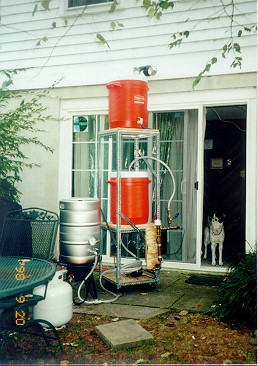

I didn't intend to build a RIMS when I decided to get into whole grain brewing. It just kind of evolved out of control. I bought 2 ten gallon Gott coolers, a Phil's Phalse bottom and a Phil's sparge arm to do infusion mashing. At the same time, I bought a boil kettle set up and an outdoor burner from Sabco. A pump wasn't even in my plans at this point, I wanted to use gravity as much as possible. As I sat down and started planing out how I was going to make this all work together smoothly, I quickly realized that I would have to have a set up that was way too tall. I decided to get a pump to make the transfer from the boil kettle to the carboys and hot liquor tank easier. At least this way, I could leave the boil kettle on ground level.
The frame was built, the pump installed, everything
was ready to go. Then I made the mistake of surfing the web and looking
at other people's RIMS. I was hooked. I based the heating element
control part of my RIMS on the setup built by Keith
Royster, who has been very helpful in answering my questions and working
with me on design problems. Thanks Keith. The rest of the design
is from my own imagination. I am not going to repeat all of the information
that Keith put on his page, he did an excelent job. I just want to
show the way I did it.
 One
place I diverged a little from Keith's design is the heating element housing.
Instead of taking the element out from the top for cleaning and having
to leave the wires exposed to the environment and my accidental touch,
I used a compression fitting in the center of the element housing that
allows me to open the housing so I can clean the element after the mash.
The compression fitting on the output side of the element housing is unnecessary
and I removed it shortly after this picture was taken because it made the
return side too long. After talking to Keith about temperature overshoot,
he suggested moving the thermocouple to the output side of the heating
element vs. the input side as is shown in his original design. In
this picture, you can also see the PID (temperature controller)
that is mounted in the side of a plastic breaker switch box.
One
place I diverged a little from Keith's design is the heating element housing.
Instead of taking the element out from the top for cleaning and having
to leave the wires exposed to the environment and my accidental touch,
I used a compression fitting in the center of the element housing that
allows me to open the housing so I can clean the element after the mash.
The compression fitting on the output side of the element housing is unnecessary
and I removed it shortly after this picture was taken because it made the
return side too long. After talking to Keith about temperature overshoot,
he suggested moving the thermocouple to the output side of the heating
element vs. the input side as is shown in his original design. In
this picture, you can also see the PID (temperature controller)
that is mounted in the side of a plastic breaker switch box.
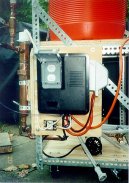 This
is a front view of the breaker switch box that houses all of the electronic
components. The power is run from an outlet on the house into a GFI
outlet on the right side of the breaker box. The pump and the PID
are plugged into the GFI outlet. I put switches in the circuit so
I can turn the pump and the PID on and off as needed without unplugging
them. Below the box, you can see the Solid State Relay(SSR) that
the PID uses to turn the heating element on and off.
This
is a front view of the breaker switch box that houses all of the electronic
components. The power is run from an outlet on the house into a GFI
outlet on the right side of the breaker box. The pump and the PID
are plugged into the GFI outlet. I put switches in the circuit so
I can turn the pump and the PID on and off as needed without unplugging
them. Below the box, you can see the Solid State Relay(SSR) that
the PID uses to turn the heating element on and off.
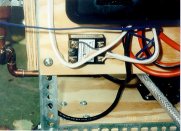 This
is a close up view of the SSR. The right side comes from the output
on the PID, polarity matters at this point so it is important the the wire
in the positive output is the same wire on the positive input. The
left side of the SSR controls the heating element. The polarity doesn't
matter on this side so you wire it just like a light switch, one of the
wires
is split and connected to both sides. The PID doesn't supply power
to the heating element, it just controls the switch. The heating
element gets its power from the same circuit as the PID.
This
is a close up view of the SSR. The right side comes from the output
on the PID, polarity matters at this point so it is important the the wire
in the positive output is the same wire on the positive input. The
left side of the SSR controls the heating element. The polarity doesn't
matter on this side so you wire it just like a light switch, one of the
wires
is split and connected to both sides. The PID doesn't supply power
to the heating element, it just controls the switch. The heating
element gets its power from the same circuit as the PID.
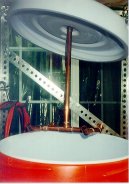 My
return manifold is a simple H shape. Nothing spectacular here, I
just tried to center the output in the four quadrants of the mash tun.
I had to drill a hole in the top of the lid so I could adjust the height
of the manifold depending on how much grain is in the mash tun. This
is the only permanent modification that I had to make to the Gott coolers.
My
return manifold is a simple H shape. Nothing spectacular here, I
just tried to center the output in the four quadrants of the mash tun.
I had to drill a hole in the top of the lid so I could adjust the height
of the manifold depending on how much grain is in the mash tun. This
is the only permanent modification that I had to make to the Gott coolers.
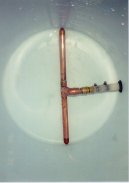 I
started out using a Phil's Phalse bottom but couldn't get it to work.
I was afraid that the thick pad included with the Phalse Bottom would restrict
the liquid flow and I couldn't get it to stop floating without the pad.
The black rubber gasket fits the 1/2" braided hose very snug. I bought
the gasket at the hardware store and then used a little dish soap to lubricate
it enough to feed the hose into the bucket. The manifold has small
holes drilled in the bottom to allow liquid to flow but keep grain from
getting in. It fits snug to the sides of the cooler and stays in
place quite nicely.
I
started out using a Phil's Phalse bottom but couldn't get it to work.
I was afraid that the thick pad included with the Phalse Bottom would restrict
the liquid flow and I couldn't get it to stop floating without the pad.
The black rubber gasket fits the 1/2" braided hose very snug. I bought
the gasket at the hardware store and then used a little dish soap to lubricate
it enough to feed the hose into the bucket. The manifold has small
holes drilled in the bottom to allow liquid to flow but keep grain from
getting in. It fits snug to the sides of the cooler and stays in
place quite nicely.
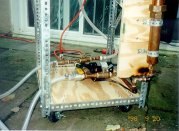 The
pump is the heart of the system. I got mine from Moving
Brews, they were very knowledgeable and helpful, I highly recommend
them. The far side of the picture is where the input from the mash
tun and boil kettle comes in. The near side is where output is directed
to the heating element and to a hose that I can use to fill the hot liquor
tank, carboys and the boil kettle during sparging.
The
pump is the heart of the system. I got mine from Moving
Brews, they were very knowledgeable and helpful, I highly recommend
them. The far side of the picture is where the input from the mash
tun and boil kettle comes in. The near side is where output is directed
to the heating element and to a hose that I can use to fill the hot liquor
tank, carboys and the boil kettle during sparging.
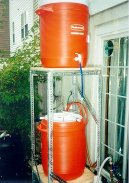 Here,
I have the system set up for sparging. I found it easier and faster
to fill the hot liquor tank on the ground and lift it to the top shelf
of the rack. The pump will fill the cooler without having to take
it down but it takes quite a while. Gravity drives the flow of water
to the Phil's Sparge Arm and causes the arm to spin and evenly distribute
water over the grain bed. There is an in-line valve below the blue
hose that I can use to adjust the rate of flow into the mash. I use
one of the ball valves to control the flow into the boil kettle.
Here,
I have the system set up for sparging. I found it easier and faster
to fill the hot liquor tank on the ground and lift it to the top shelf
of the rack. The pump will fill the cooler without having to take
it down but it takes quite a while. Gravity drives the flow of water
to the Phil's Sparge Arm and causes the arm to spin and evenly distribute
water over the grain bed. There is an in-line valve below the blue
hose that I can use to adjust the rate of flow into the mash. I use
one of the ball valves to control the flow into the boil kettle.